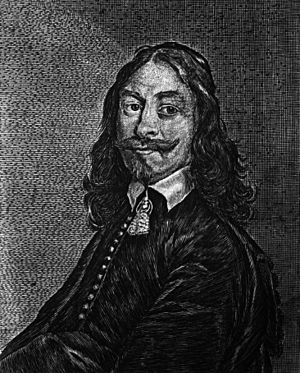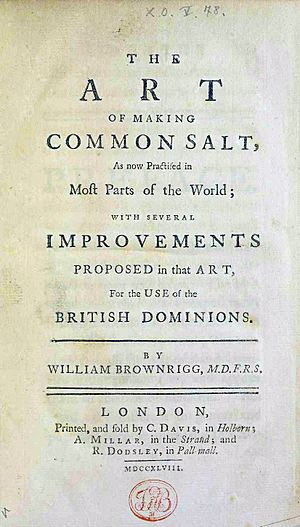William Brownrigg facts for kids
William Brownrigg (born March 24, 1712 – died January 6, 1800) was an important British doctor and scientist. He lived and worked in Whitehaven, a town in Cumberland, England. While in Whitehaven, Brownrigg did many experiments. His work on a gas called carbonic acid earned him the famous Copley Medal in 1766. He was also the first person to realize that platinum was a brand new element. He became a Fellow of the Royal Society, which is a group for top scientists.
Contents
Early Life and Learning
William Brownrigg was born at High Close Hall, near Plumbland. His father, George Brownrigg, was a local gentleman. William's mother, Mary Brownrigg, came from Ireland.
William started learning Latin and Greek from a local priest when he was 13. By the age of 15, he was training to be a pharmacist in Carlisle. After that, he spent two years studying with a surgeon in London. Then, he went to Leiden University in the Netherlands. There, he learned from famous professors like Boerhaave. In 1737, he earned his degree as a Doctor of Medicine (MD). His special paper was about how doctors practice medicine.
Medical Work in Whitehaven
After finishing his studies, Brownrigg returned to Britain. He began working as a doctor with Richard Senhouse in Whitehaven. Mr. Senhouse passed away soon after, so Brownrigg became the main doctor in the area for many years. His old patient notes from 1737 to 1742 still exist today. They describe his patients and the medicines he used. They also contain some of the earliest English notes about a sickness called puerperal fever.
In 1741, Brownrigg married Mary Spedding. Mary's family managed the coal mines for James Lowther. The Lowther family had helped Whitehaven become a big seaport. This connection helped William become more important in the community. It also made him very interested in the health of the miners.
Later, in 1771, there was a worry about a sickness spreading from Europe. Brownrigg had studied outbreaks of typhus in Whitehaven. He then wrote a paper about how to stop sickness from spreading.
Amazing Science Discoveries
Brownrigg's interest in medicine led him to study the gases that miners breathed. These included fire damp (methane) and choke damp (air with not enough oxygen). Carlisle Spedding helped Brownrigg build a laboratory. This lab received gases from a nearby coal mine through lead pipes. Brownrigg found ways to collect and move these gases. He even sent gas-filled bags to James Lowther to show to The Royal Society. Because of his work, Brownrigg was chosen as a Fellow of the Royal Society.
His experiments with gases continued. After visiting a spa in Germany, he became interested in gases found in mineral waters. He published a paper about the "elastic spirit or air" in a special water called Pouhon water. This paper won him the important Copley Medal in 1766.
Finding Platinum
In 1741, Brownrigg's relative, Charles Wood, who worked with metals, found some samples of platinum in Jamaica. He sent them to Brownrigg to study. In 1750, after looking closely at the platinum, Brownrigg told the Royal Society all about it. He said he had never seen any mention of this metal before. Brownrigg wrote down Wood's experiments and did some of his own. He was the first to realize that platinum was a brand new element. By sharing this discovery with The Royal Society, he encouraged other scientists to start studying it too.
Making Salt Better
Brownrigg also wrote an important book about how to make salt. He hoped that if Britain could make more of its own salt, it would not need to buy it from other countries. This would help Britain's fishing industry and its economy. At that time, much of the best salt came from France and Spain. These were countries Britain often fought with. When a paper based on his book was read at the Royal Society in 1748, it was considered very important.
Meeting Benjamin Franklin
In 1771, Benjamin Franklin was visiting Britain with Sir John Pringle. Pringle told Franklin to visit William Brownrigg. Franklin stayed at Brownrigg's home, Ormathwaite, in the Lake District. Brownrigg gave him a signed copy of his book about salt. Franklin showed Brownrigg an experiment on Derwent Water. He poured oil on the water's surface to calm the waves. Later, Franklin and Brownrigg wrote letters to each other about this experiment. This led to another paper for The Royal Society.
Other Interests
Brownrigg was not just a doctor and scientist; he was also a businessman. In 1765, he partnered with Anthony Bacon to grow the iron industry in Wales. This helped the town of Merthyr Tydfil grow, especially the Cyfarthfa Ironworks. He also owned part of a rope-making business and invested in local roads.
When he retired to Ormathwaite, he became interested in improving farming in the area. He studied minerals and encouraged Thomas West to write A Guide to the Lakes. This was the first guide book for the beautiful Lake District. Brownrigg also held several important jobs. He was a magistrate (a type of judge) and collected government taxes for Cumberland and Westmorland.
William Brownrigg passed away in 1800. He was buried at Crosthwaite church. His friend and writer, Joshua Dixon, felt that Brownrigg's important work was sometimes overlooked. This was because Brownrigg was very modest and did not like to leave his home county of Cumberland later in life.



